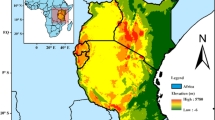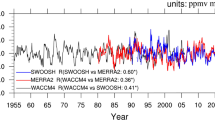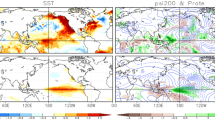Abstract
This study examines the combined influence of El Niño-Southern Oscillation (ENSO) and the Indian Ocean Dipole (IOD) on Upper Troposphere Lower Stratosphere (UTLS) ozone variability. The investigation employs data from the Microwave Limb Sounder (MLS) aboard the Aura Satellite and the European Centre for Medium-Range Weather Forecasts (ECMWF) ERA5 reanalysis, spanning the period 2005–2020 across tropical latitudes (20º N–20º S). Three specific events were chosen for analysis: a strong La Niña event in 2010, the co-occurrence of El Niño and moderate IOD in 2015, and a robust IOD event in 2019. During years marked by the simultaneous occurrence of ENSO and IOD events, the UTLS (100 hPa altitude is considered for the present study. 82 hPa is the altitude just above the tropopause, therefore also shown in the results) ozone mixing ratio demonstrates a decline in absolute values. The Quasi-biennial Oscillation (QBO) was also investigated, revealing a synchronized variation with the ozone anomaly in the UTLS region. Furthermore, the calculated eddy heat flux, utilized as a proxy for the Brewer–Dobson Circulation (BDC), aligns with the UTLS ozone anomalies, indicating a positive (negative) anomaly during periods of intense tropical downwelling (upwelling). To quantitatively elucidate the contributions of ENSO, IOD, and QBO to the observed ozone anomaly, a multivariate linear regression analysis was executed utilizing the least square method. The findings underscore that a notable fraction—about one-fourth of the observed UTLS ozone anomaly within the study timeframe (2005–2020) can be attributed collectively to ENSO, IOD, and QBO. This preliminary exploration underscores the substantial role played by large-scale climate drivers emanating from the Pacific and Indian oceans in shaping UTLS ozone distribution. These insights emphasize the significance of considering these climatic influences when examining the intricate dynamics and variability of UTLS ozone patterns.








Similar content being viewed by others
Data availability
Nino3.4 index on: https://psl.noaa.gov/gcos_wgsp/Timeseries/Nino34/. IOD index on: https://psl.noaa.gov/gcos_wgsp/Timeseries/DMI. QBO data on: https://www.geo.fu-berlin.de/met/ag/strat/produkte/qbo/qbo.dat. ERA5 parameters on: https://cds.climate.copernicus.eu/cdsapp#!/dataset/reanalysis-era5-pressure-levels?tab=form. MLS ozone, water vapor, and temperature on: https://mls.jpl.nasa.gov.
References
Andrews et al (1987) middle atmosphere dynamics, 40, ISBN: 9780080511672
Annamalai H, Murtugudde R, Potemra J, Xie SP, Liu P, Wang B (2003) Coupled dynamics in the Indian Ocean: Spring initiation of the zonal mode. Deep-Sea Res 50B:2305–2330
Birner T, Boenisch H (2011) Residual circulation trajectories and transit times into the extratropical lowermost stratosphere. Atmos Chem Phys 11:817–827. https://doi.org/10.5194/acp-11817-2011
Bognar K et al (2022) Stratospheric ozone trends for 1984–2021 in the SAGE II–OSIRIS–SAGE III/ISS composite dataset. Atmos Chem Phys 22:9553–9569
Brewer AW (1949) Evidence for a world circulation provided by the measurements of helium and water vapour distribution in the stratosphere. Q J R Meteor Soc 75:351–363. https://doi.org/10.1002/qj.49707532603
Bucci S et al (2020) Deep-convective influence on the upper troposphere–lower stratosphere composition in the Asian monsoon anticyclone region: 2017 StratoClim campaign results. Atmos Chem Phys 20:12193–12210
Butchart N (2014) The Brewer-Dobson circulation. Rev Geophys 52:157–184. https://doi.org/10.1002/2013RG000448
Davies TD, Schuepbach E (1994) Episodes of high ozone concentrations at the earth’s surface resulting from transport down from the upper troposphere/lower stratosphere: a review and case studies. Atmos Environ 28(1):53–68
Dessler A (2000) Chemistry and physics of stratospheric ozone. 74, ISBN: 9780122120510
Dessler A et al (2013) Stratospheric water vapor feedback. PNAS 110:18087–18091
Diallo M et al (2022) Stratospheric water vapour and ozone response to the quasi-biennial oscillation disruptions in 2016 and 2020. Atmos Chem Phys 22:14303–14321
Dwyer JG, O’Gorman PA (2017) Changing duration and spatial extent of midlatitude precipitation extremes across different climates. Geophys Res Lett 44:5863–5871
Eliassen A, Palm E (1961) On the transfer of energy in stationary mountain waves. Geofys Publ 22(3):1–23
Fadnavis S et al (2023) Comparison of ozone sonde measurements in the upper troposphere and lower Stratosphere in Northern India with reanalysis and chemistry-climate-model data. Sci Rep 13:7133. https://doi.org/10.1038/s41598-023-34330-5
Flury T et al (2013) Variability in the speed of the Brewer-Dobson circulation as observed by Aura/MLS. Atmos Chem and Phys 13(9):4563–4575
Forster PiersShine MdFKP (2002) Assessing the climate impact of trends in stratospheric water vapor. Geo Res Lett 29(6):1086. https://doi.org/10.1029/2001GL013909
Fueglistaler S et al (2009) Tropical tropopause layer. Rev Geophys 47:RG1004. https://doi.org/10.1029/2008RG000267
Gamelin B et al (2020) The combined influence of ENSO and PDO on the spring UTLS ozone variability in South America. Clim Dyn 55:1539–1562
Gualdi S, Guilyardi E, Navarra A, Masina S, Delecluse P (2003) The interannual variability in the tropical Indian Ocean as simulated by a CGCM. Clim Dyn 20:567–582
Harris NRP et al (2008) Ozone trends at northern mid- and high latitudes—a European perspective. Ann Geophys 26:1207–1220. https://doi.org/10.5194/angeo-26-1207-2008
Hersbach H et al (2020) The ERA5 global reanalysis. Q J R Meteorol Soc 146:1999–2049
Holton JR, Tan HC (1980) The influence of the equatorial quasi-biennial oscillation on the global circulation at 50 mb. J Atmos Sci 37:2200–2208
Knibbe JS, Van Der ARJ, de Laat ATJ (2014) Spatial regression analysis on 32 years of total column ozone data. Atmos Chem Phys 14:8461–8482. https://doi.org/10.5194/acp-14-8461-2014
Konopka P, Grooß JU, Plöger F, Müller R (2009) Annual cycle of horizontal in‐mixing into the lower tropical stratosphere. J Geophys Res Atmos 114:1–7
Krzyścin JW (2016) El Niño-Southern Oscillation and Indian Ocean dipole contribution to the Zonal Mean Total Ozone in the Northern Hemisphere. Int J Climatol 37:3517–3524. https://doi.org/10.1002/joc.4933
Kumar KR, Singh BB, Kumar KN (2021) Intriguing aspects of Asian Summer monsoon anticyclone ozone variability from microwave limb sounder measurements. Atmos Res 253:105479. https://doi.org/10.1016/j.atmosres.2021.105479
Lau NC, Nath MJ (2023) Atmosphere–ocean variations in the Indo-Pacific sector during ENSO episodes. J Clim 16:3–20
Lee T, Hobbs WR, Willis JK, Halkides D, Fukumori I, Armstrong EM, Hayashi AK, Liu WT, Patzert W, Wang O (2010) Record warming in the South Pacific and western Antarctica associated with the strong central-Pacific El Niño in 2009–10. Geophys Res Lett 37:L19704. https://doi.org/10.1029/2010GL044865
Legras B, Bucci S (2020) Confinement of air in the Asian monsoon anticyclone and pathways of convective air to the stratosphere during the summer season. Atmos Chem Phys 20(18):11045–11064
Li T, Wang B, Chang CP, Zhang YS (2003) A theory for the Indian Ocean dipole-zonal mode. J Atmos Sci 60:2119–2135
Lu X et al (2018) Lower tropospheric ozone over India and its linkage to the South Asian monsoon. Atmos Chem Phys 18:3101–3118. https://doi.org/10.5194/acp-18-3101-2018
Lu B et al (2020) What caused the extreme Indian Ocean dipole event in 2019? Geophys Res Lett 47(11):1–18
Manney GL et al (2005) EOS MLS observations of ozone loss in the 2004–2005 Arctic winter. Geo Res Let 33:L04802. https://doi.org/10.1029/2005GL024494
Ming A, Hitchcock P (2022) What contributes to the inter-annual variability in tropical lower stratospheric temperatures? J Geophys Res Atmos 127:e2021JD035548
Mitchell DM et al (2015) Signatures of naturally induced variability in the atmosphere using multiple reanalysis datasets. QJRMS 141(691):2011–2031
Nassar R et al (2009) Analysis of tropical tropospheric ozone, carbon monoxide, and water vapor during the 2006 El Niño using TES observations and the GEOS-Chem model. J Geophys Res 114:D17304. https://doi.org/10.1029/2009JD011760
Newman P et al (2001) What controls the temperature of the Arctic stratosphere during the spring? J Geo Res 106:19999–20010
Pillai PA et al (2010) Individual and combined influence of El Niño-Southern Oscillation and Indian Ocean Dipole on the Tropospheric Biennial Oscillation. QJRMS. https://doi.org/10.1002/qj.579
Ploeger et al (2013) Horizontal water vapor transport in the lower stratosphere from subtropics to high latitudes during boreal summer. J Geophys Res Atmos 118(14):8111–8127
Plumb RA (2002) Stratospheric transport. J Meteorol Soc Jpn 80:793–809. https://doi.org/10.2151/jmsj.80.793
Plumb RA, Bell RC (1982) A model of the quasi-biennial oscillation on an equatorial beta-plane. QJRMS 108(456):335–352
Portmann RW et al (2012) Stratospheric ozone depletion due to nitrous oxide: influences of other gases. Philos Trans R Soc B Biol Sci 367(1593):1256–1264
Poshyvailo-Strube L et al (2022) How can Brewer-Dobson circulation trends be estimated from changes in stratospheric water vapour and methane? Atmos Chem Phys 22(15):9895–9914
Randel WJ, Wu F, Vömel H, Nedoluha G, Forster PMD (2006) Decreases in stratospheric water vapor after 2001: links to changes in the tropical tropopause and the Brewer-Dobson circulation. J Geophys Res 111:D12312. https://doi.org/10.1029/2005JD006744
Randel WJ, Garcia RR, Calvo N, Marsh D (2009) ENSO influence on zonal mean temperature and ozone in the tropical lower stratosphere. Geophys Res Lett 36:L15822. https://doi.org/10.1029/2009GL039343
Randel WJ, Wu F, Ming A, Hitchcock P (2021) A simple model of ozone–temperature coupling in the tropical lower stratosphere. Atmos Chem Phys 21(24):18531–18542
Ratna SB et al (2021) The extreme positive Indian Ocean dipole of 2019 and associated Indian summer monsoon rainfall response. Geophys Res Lett 48(2):e2020GL091497
Rieder HE et al (2013) On the relationship between total ozone and atmospheric dynamics and chemistry at mid-latitudes – Part 2: The effects of the El Niño/Southern Oscillation, volcanic eruptions and contributions of atmospheric dynamics and chemistry to long-term total ozone changes. Atmos Chem Phys 13:165–179. https://doi.org/10.5194/acp-13-165-2013
Saji S et al (1999) A dipole mode in the tropical Indian Ocean. Nature 401(6751):360–363
Singh BB, Krishnan R, Ayantika DC et al (2021) Linkage of water vapor distribution in the lower stratosphere to organized Asian summer monsoon convection. Clim Dyn 57:1709–1731. https://doi.org/10.1007/s00382-021-05772-2
Steinbrecht W, Hassler B, Claude H, Winkler P, Stolarski RS (2003) Global distribution of total ozone and lower stratospheric temperature variations. Atmos Chem Phys 3:1421–1438. https://doi.org/10.5194/acp-3-1421-2003
Thompson A et al (2021) Regional and seasonal trends in tropical ozone from SHADOZ profiles: reference for models and satellite products. J Geophys Res Atmos 126(22):e2021JD034691
Vogel B et al (2023) Reconstructing high-resolution in- situ vertical carbon dioxide profiles in the sparsely monitored Asian monsoon region. Commun Earth Environ 4:72. https://doi.org/10.1038/s43247-023-00725-5
Weber M et al (2011) The Brewer-Dobson circulation and total ozone from seasonal to decadal time scales. Atmos Chem Phys 11(21):11221–11235
Webster PJ et al (1999) Coupled Ocean–atmosphere dynamics in the Indian Ocean during 1997–98. Nature 401(6751):356–360
Zerefos CS, Bais AF, Ziomas JC, Bojkov RD (1992) On the relative importance of Quasi-Biennial Oscillation and El Niño/Southern Oscillation in the Revised Dobson Total Ozone ˜ Records. J Geophys Res 97:10135–10144
Zhang J et al (2021) The role of chemical processes in the quasi-biennial oscillation (QBO) signal in stratospheric ozone. Atmos EnvIron. https://doi.org/10.1016/j.atmosenv.2020.117906
Zou H, Zhou L, Gao Y, Chen X, Li P, Ji C, Ma S, Gao D (2005) Total ozone variation between 50° and 60°N. Geophys Res Lett. https://doi.org/10.1029/2005GL024012. (issn: 0094-8276)
Acknowledgements
The authors are thankful to the Aura-MLS team and to the European Centre for Medium-Range Weather Forecasts (ECMWF) team for providing the ozone mixing ratios, winds, and temperature datasets. The authors also thank the National Oceanic and Atmospheric Administration (NOAA) for providing the sea surface temperatures which helped to calculate ENSO and IOD indexes. The authors thank the free university of Berlin for the QBO winds data.
Author information
Authors and Affiliations
Corresponding author
Ethics declarations
Conflict of interest
The authors declare that they have no known competing interest. The authors declare no conflict of interest, financial interests, or personal relationships that could have appeared to influence the work reported in this paper.
Additional information
Responsible Editor: Clemens Simmer, Ph.D.
Publisher's Note
Springer Nature remains neutral with regard to jurisdictional claims in published maps and institutional affiliations.
Rights and permissions
Springer Nature or its licensor (e.g. a society or other partner) holds exclusive rights to this article under a publishing agreement with the author(s) or other rightsholder(s); author self-archiving of the accepted manuscript version of this article is solely governed by the terms of such publishing agreement and applicable law.
About this article
Cite this article
Nath, O., Singh, B.B. & Kunchala, R.K. El Niño Southern Oscillation (ENSO) and Indian Ocean Dipole (IOD) signatures in tropical ozone in the Upper Troposphere Lower Stratosphere (UTLS). Meteorol Atmos Phys 136, 10 (2024). https://doi.org/10.1007/s00703-024-01007-1
Received:
Accepted:
Published:
DOI: https://doi.org/10.1007/s00703-024-01007-1




